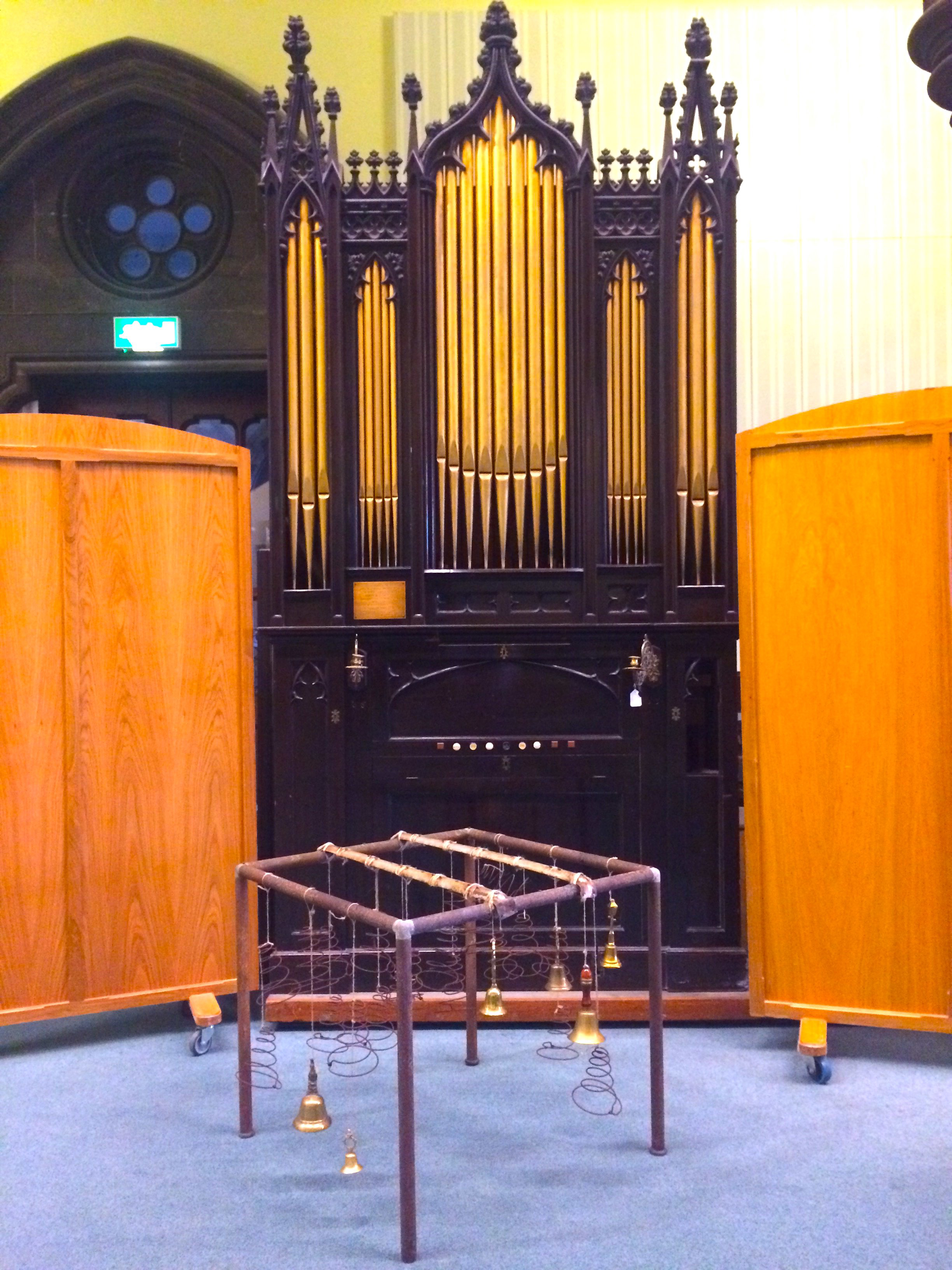Pangeometrophany
found objects, metal, rhizome wires, wood, rope, antique hand bells, custom electronics, iron nails, 2 channel video, 3D audio score, stereo PA broadcasting, custom amps
(exhibited at the Great Rotunda Concert Hall in the University of Glasgow, August 2016)
(exhibited at the Great Rotunda Concert Hall in the University of Glasgow, August 2016)



ABSTRACT
Based on presenting a selection of original sound works titled CAL>CHU*rch (i.e. Caledonia Road Church Re-imagined), this portfolio was initially developed in hopes of making perceptible a pre-existing environment of an obsolete building in a public art space. The structure in question is a Caledonia Road Church in Gorbals area of Glasgow, which perished in a fire in 1968. The research morphed into a study of simultaneous recognition and rendition of sound in space. By investigating how sound articulates a space within a space, this portfolio examines pangeometrophonic (sic) relationship between multiple broadcasting elements within a sound installation, which is crucial for setting up an all-encompassing, sensatory immersive environment. Installation CAL>CHU*rch is a hybrid of interfaces. Through devising a personal practice that utilizes a range of mediums and techniques, a focus of installation became to develop a combination of both corporeal and incorporeal site-specific
sound works. CAL>CHU*rch relies on an array of broadcasting media, including a/v projection, sounding sculpture and 3D soundscape composition via a personal playback device to allow the audience to re-imagine the architectural site in question at any exhibiting location. The installation also opens a dialogue about the site’s role in a modern urban setting and what would constitute its present “soundscape” profile.
CONVENTIONS OF MATERIALS USED
Examining Bernard Leitner's “Sound-Space Investigations 69-75” the sound was to become an auxiliary building material when restructuring the space of the Caledonia Church. Like plaster or wood, it would partake in creating a fundamental shape of the building. Thus, the key method of my experimental study became a layering technique, applied to:
• layering of noises
• layering of medias (stereo and binaural audio formats, still images, video, sculpture, animation)
• layering of original source recordings (recorded across cathedrals in Glasgow, Hamburg and New York City)
• layering of senses invited to participate (video for sight, sculpture for tactile participation, audio for hearing stimuli, all aimed to
evoke emotions and represent memories)
• layering of broadcasting devices (PA system, headphones, acoustic instruments, mini mono speakers)
COMMENTARY
The thesis (available for download) is intended to situate my writing within a context of my own experiments with sound. I attempt to answer the
following questions: can we change our perception of an existing environment (i.e. an installation site) through sound? How can we
create an alternative environment through employing sonic art practices? Developing a post-medium approach (Krauss, 2000), what
methodologies of sound art are relevant when re-imagining the space? What factors are important to consider when building or rebuilding
sonic environments?
Another motivation behind the research was to investigate and develop a personal approach to sound installations. In particular, the experiments attempted to explore the unique relationships between the range of media displayed in CAL>CHU*rch. Construction of the
installation and exchange between its elements carries a vital interdependence. By referencing El Lissitzky pangeometry discussions within cubism and visual arts and his emphasis on presenting existing simultaneous view perspectives within a space, I came to develop a derivative term, applicable to sonic aesthetics and sound installations, titled pangeometrophony.
Pangeometrophony is
a survey of simultaneous layering of multiple sound transmitting points, and interdependence of auditory perspectives in space. Applying this strategy to CAL>CHU*rch (diagram), each element works interdependently with others within the spatial arrangement. The soundscape composition accompanying video installation is in a stereo format and creates a low ambient backdrop with time stretched whispering and bell ringing, sonically connecting and mirroring the sounds of the physical sculpture. The sculpture in turn is visually represented by one of the videos. The other video showcases layered video files, filmed at different locations, audio recordings from which in turn are used in the binaural composition available for playback via headphones. Sounds emitted from mini speakers built into the sculpture also reflect on video recordings.
